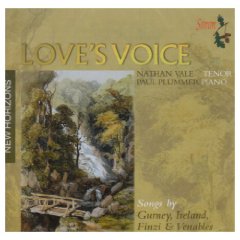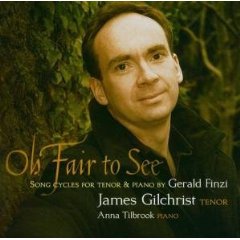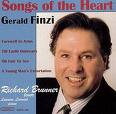I say, "I'll seek her"
Poet: Thomas Hardy
Date of poem: (undated)
Publication date: In the collection: Time's Laughingstocks (1909)
Publisher: Macmillan Publishing Company
Collection: Time's Laughingstocks and Other Verses (1909) under the heading "More Love Lyrics."
History of Poem: The poem comes from the collection: Time's Laughingstocks and Other Verses which was published in 1909 by Macmillan Publishing Company. "I Say, 'I'll Seek Her" is found within a sub-group of Time's Laughingstocks and Other Verses entitled: "More Love Lyrics." There are twenty-six poems within "More Love Lyrics," and "I Say, 'I'll Seek Her" is the sixth poem in the group. It has been suggested that the poem is autobiographical of Hardy's own affairs. "More Love Lyrics" were written between 1866 and 1900 and according to James Osler Bailey "some of the poems are identifiable with Hardy's experiences of young love and his dreams, for instance, of an actress whom, presumably, he saw only from a seat in the theatre; others are reflections of his emotional experiences in mature life, long after marriage." (Bailey, 210)
Poem
| 1 | I SAY, ‘I’ll seek her side | a |
| 2 | Ere hindrance interposes;’ | b |
| 3 | But eve in midnight closes, | b |
| 4 | And here I still abide. | a |
| 5 | When darkness wears I see | c |
| 6 | Her sad eyes in a vision; | d |
| 7 | They ask, ‘What indecision | d |
| 8 | Detains you, Love, from me? – | c |
| 9 | ‘The creaking hinge is oiled, | e |
| 10 | I have unbarred the backway, | f |
| 11 | But you tread not the trackway; | f |
| 12 | And shall the thing be spoiled? | e |
| 13 | ‘Far cockcrows echo shrill, | g |
| 14 | The shadows are abating, | h |
| 15 | And I am waiting, waiting; | h |
| 16 | But O, you tarry still!’ | g |
(Hardy, 222-3) |
||
Content/Meaning of the Poem:
1st stanza: I say to myself, I will pursue her before all impediments that separate us, and yet I still remain here.
2nd stanza: As I grow tired I see her sad in my mind's eye; her eyes say to me, 'what inability to decide keeps you, my Love, from coming to me? -
3rd stanza: The hinge that creaks has been oiled, I have made clear the backway in, but you don't come; have all my plans been upset?
4th stanza: The rooster crows pierces my foggy thoughts, and I am still waiting for you; but alas, you still do not come!
For additional comments as to possible meaning of the text please refer to: Content - Van der Watt.
Speaker: Possibly Thomas Hardy
Setting: A rendezvous.
Purpose: To remind one that human beings are incredibly selfish when it comes to love.
Idea or theme: Love and Selfishness
Style: The poem is written in a lyrical style.
Form: According to Gerhardus Daniël Van der Watt, "The poem consists of four quatrains of which the middle two lines are indented and the outer lines are shortened in some cases. The rhyme scheme is: abba cddc effe ghhg. An iambic metre is consistently used throughout the poem." (Van der Watt, 68)
Synthesis: The speaker begins rather definitively as if attempting to conjure up the nerve to follow through on the plan to rendezvous. By the time midnight has come and gone the guilt of why he hasn't followed through eats at him. In the second stanza the speaker, possibly because of his guilt, begins to see through the eyes of his lover and hears her voice asking what is keeping him. Her voice continues emanating from the speaker saying 'all has been prepared for you, I have made sure the hinge is oiled, and the back way is free and open.' The guilt continues to mount-up on the speaker. In the last stanza the lover explains how the night has come to an end and yet the speaker has not come. Whether or not this poem is autobiographical we do not know but it is interesting to peer into the Psyche of Hardy. One may ponder as to his own guilt of affairs that he had. Possibly this poem was to remind him of an affair that did not come to fruition or is it offered to remind us that two individuals feelings are at stake and ones selfish desires need to be kept in check.
Published comments: F. B. Pinion writes with regards to I Say, 'I'll Seek Her: "The poem is mainly fantasy, but it could have been written with 'Her Immortality' and Hardy's 'lost prize' Tryphena in mind, when his mood and situation were like those which engendered 'In Tenebris' (III)."
(Pinion, 71)
James Osler Bailey writes: " "I SAY I'LL SEEK HER" exhibits Hardy's sensitivity to the pain of others, evident in his vision of the woman's pain when her lover fails to appear. If the woman is Tryphena Sparks, the poet's failure to "seek her side" may reflect his indecision between her and Emma Gifford."
(Bailey, 214)
F. B. Pinion writes: "The 'cockcrows' suggest the departure of the spirit which has been calling him (cf. Hamlet, I. i. 147-65)."
(Pinion, 71)
✦✼✦✼✦✼✦✼✦✼✦✼✦✼✦✼✦✼✦✼✦✼✦✼✦✼✦✼✦✼✦✼✦✼✦
Time's Laughingstocks and Other Verses
- Collection of 94 poems written by Thomas Hardy.
- Published in December of 1909 by Macmillan and Company.
- Poems were written over a period of 40 years.
F. B. Pinion categorizes the poems as generally somber in tone with some having a more light-hearted nature. (Pinion, 64)
Edmund Gosse wrote on Dec. 7, 1909, "how poignantly sad! What makes you take such a hopelessly gloomy view of existence?" (Pinion, 64)
"A reviewer for the Daily News complained that, throughout the volume, 'the outlook [is] that of disillusion and despair." (Wright, 313)
Hardy responded to the reviewer by saying more than half do not fit the description.
(Wright, 313)
Gerald Finzi set the following poems within this collection:
- 1967 [titled by Finzi as: In five-score summers!] (I Said To Love)
- Former Beauties (A Young Man's Exhortation)
- He Abjures Love (Before and After Summer)
- In The Mind's Eye (Before and After Summer)
- I Say, 'I'll Seek Her' (Oh Fair To See)
- Let Me Enjoy (Till Earth Outwears)
- The Market Girl (Till Earth Outwears)
- The Sigh (A Young Man's Exhortation)
Helpful Links:
✦✼✦✼✦✼✦✼✦✼✦✼✦✼✦✼✦✼✦✼✦✼✦✼✦✼✦✼✦✼✦✼✦✼✦
Musical Analysis
Composition date: 1929 (Banfield, 144)
Publication date: © Copyright 1966 by Boosey and Co. Ltd. (Finzi, 65)
Publisher: Boosey & Hawkes
Tonality: The song begins and ends in E minor but there are four modulations before returning to E minor. The modulations are: E minor to B-flat major in measure three; B-flat major to D major in measure six; D major to B minor in measure ten, and B minor to E minor in measure 12. (Van der Watt, 72)
Transposition: The song is available in C minor a major third lower than the original key. The transposed version may be found in the Medium/Low Voice edition by Boosey & Hawkes entitled: Gerald Finzi Collected Songs 54 Songs Including 8 Cycles or Sets.
Duration: Approximately two minutes and thirty-two seconds
Meter: For the most part the song is in 4/4 with the exception of six measures that utilize 3/4. Finzi's use of 3/4 in measures thirty through thirty-six along with the block chords on the down beat give one the aural impression of rocking back and forth as one might do while waiting (see example below).
Rocking motion in measures 30-34. (Finzi, 67)
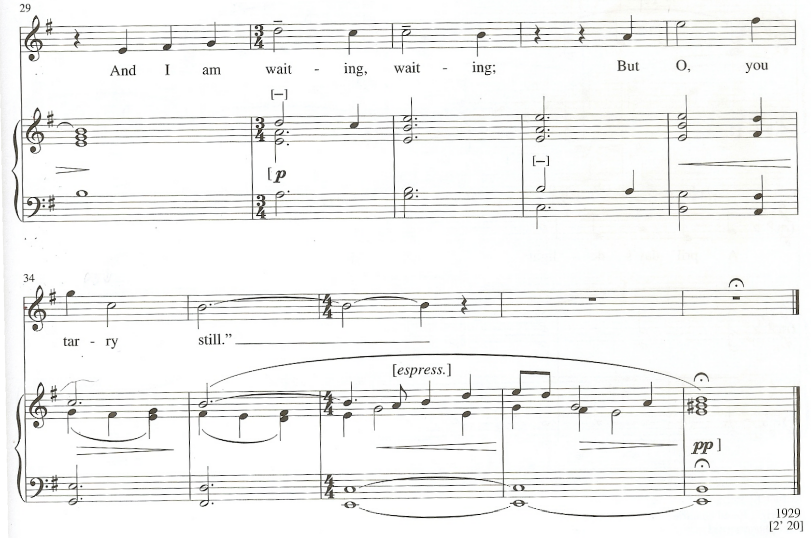
This is a perfect match for the text "And I am waiting, waiting." For additional comments about the meter within the song please refer to: Metre - Van der Watt.
Tempo: The score indicates "Fast, In modo appassionato" with the quarter note equalling c. 72. (Finzi, 65) Beyond the opening tempo marks, Finzi does ask for a ritardando in the fourth measure and continuing on until a tempo (ma rubato) is indicated with the quarter note equalling sixty-six. This tempo change corresponds with the second stanza or the middle of measure six. There are no other indications for a tempo change within the remainder of the song. For additional comments as to the tempi please refer to: Speed - Van der Watt.
Form: The song is through-composed. Gerhardus Daniël Van der Watt has created a table for the structure of the song. The table identifies locations in which the specific stanzas begin according to measure number, the phrase structure within a stanza and the total number of measures for the stanza. Van der Watt also identifies and interlude some material he labels as a link and the postlude. To view Dr. Van der Watt's table and his comments about the form of the song please refer to: Structure - Van der Watt.
Rhythm: The rhythms utilized within the song are typical of Finzi's song writing. What is not typical of many Finzi's songs is the dramatic beginning. This drama is not only a feature of the rhythm but also the dynamics, a higher tessitura in the accompaniment as well as a strong text. A typical Finzi song is text driven and this song is no exception to the norm but it just happens the drama is not in the middle or the end of the text it is in the beginning. Finzi's use running sixteenths in measures three through the middle of six help to calm things down as the text becomes more secretive and sombre. The sixteenth notes are replaced by block chords of eighths in measures seven through ten in the piano accompaniment. In measure eleven the rhythms within the piano accompaniment become more varied with the use of dotted notes and triplets taking on a more angular feel. The choice of rhythmic duration becomes more elongated until in measure twenty-one all forward movement ceases. When the vocal line reenters the text setting is less stellar than typical Finzi text setting (see example below).
Text setting in measures 23-4. (Finzi, 67)
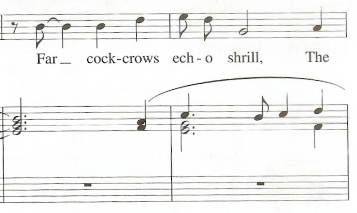
Perhaps the justification for the awkward text setting is directed at the odd text itself where Hardy is giving the listener an aural image of the dark of night being interrupted by a "shrill" crowing of a cock as the dark gives way to the dawn. The end of the song as was mentioned in the meter category above begins to rock back and forth with the use of 3/4 meter and a long short long short rhythmic figure in the vocal line. The song ends extremely subdued in comparison to the dramatic beginning. For additional comments about the use of rhythm within the song as well as a detailed description of motifs please refer to: Rhythmic motifs - Van der Watt.
A rhythmic duration analysis was performed and for the results please refer to: Rhythm Analysis. Information contained within the analysis includes: the number of occurrences a specific rhythmic duration was used; the phrase in which it occurred; the total number of occurrences in the entire song.
Melody: The vocal line is written in a typical style for Finzi with scale passages or step-wise motion broken up with small leaps. The climax of the vocal line can be found in the second stanza where Finzi has written a high [A] (in the original key) on the second syllable of "detains." Finzi also places moments before the high [A] a high [G] on the word "ask." The choice of rhythmic duration is clever in that the high [G] predicts the text "What indecision Detains you, Love, from me?" (see example below).
Climax and text setting in measures 9-11. (Finzi, 66)
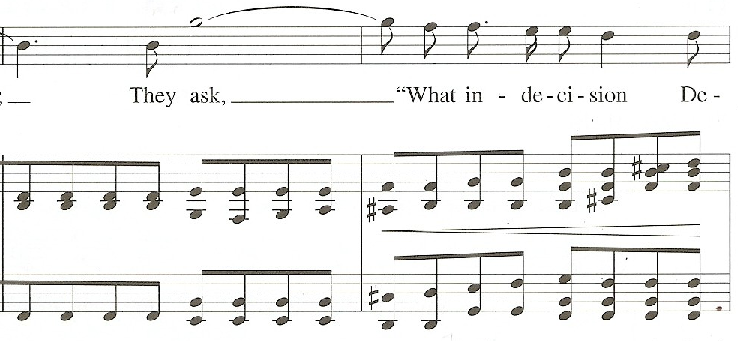
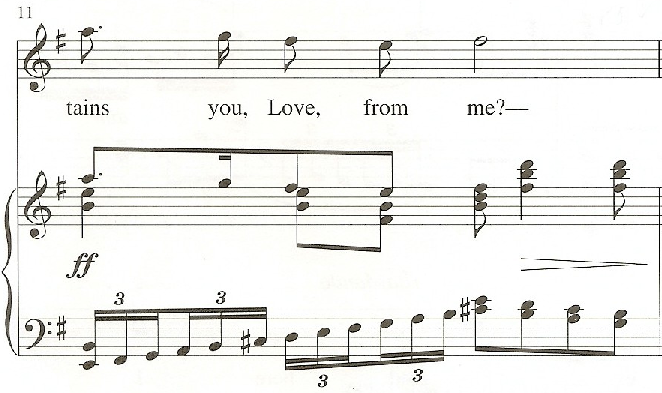
Finzi incorporates in the third stanza, measures twelve through twenty, several rests that help create the illusion of moments of thought and contemplation about whether or not the lover will meet for their rendezvous (see example below).
Contemplation in measures 12-9. (Finzi, 66)
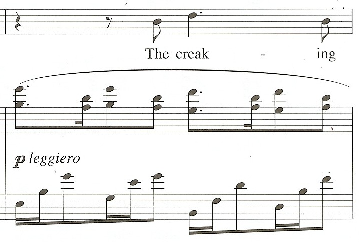
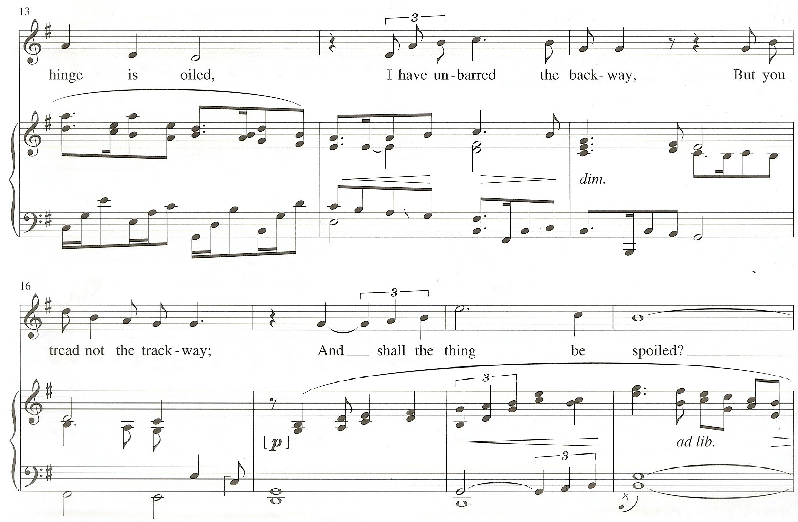
The remaining melodic material found in the vocal line supports the text as the speaker "waits" for the lover. The phrase length in the piano accompaniment from near the end of the third stanza, measure seventeen, is in contrast to the short questions and comments found in the vocal lines text. For additional comments about the melodic material within the song please refer to: Melody - Van der Watt.
An interval analysis was performed for the purpose of discovering the number of occurrences specific intervals were used and also to see the similarities if there were any between stanzas. Only intervals larger than a major second were accounted for in the interval analysis. The analysis found the most frequently used interval was the ascending perfect fourth but Finzi did not use it at all in the last stanza choosing instead to use a perfect fifth both ascending and descending two times each. For the complete results of the interval analysis please refer to: Interval Analysis.
Texture: The texture alternates between homophonic and contrapuntal activity. For additional information about the texture including a description of various harmonic elements and counterpoint please refer to: Harmony and Counterpoint - Van der Watt.
Vocal Range: The vocal range is a perfect twelfth. The lowest pitch is the D below middle C and the highest pitch is the A above middle C.
Tessitura: The tessitura of the song lies between the D below middle C and the F sharp above middle C. For a complete pitch count for each stanza please refer to: Pitch Analysis.
Dynamic Range: The song begins at fortissimo and ends quietly at pianissimo. Between the down beat and the final cadence there is some indication in most measures for dynamic variety. The climax of the song occurs in measure eleven on the text "detains." For a complete description of dynamics for each stanza please refer to: Dynamics - Van der Watt.
Accompaniment: The accompaniment is moderately difficult for stanzas one through three. The remainder of the song is calm and pensive. For a detailed description of the elements within the accompaniment please refer to: Accompaniment - Van der Watt.
Published comments: Diana McVeagh makes the following comments in her Finzi biography: "'I, say, "I'll seek her side"' (1929) is a dramatic vignette of a man wracked with indecision, a woman tormented by waiting. From the headlong passionate opening the music gradually loses impetus to mirror the man's procrastination. This control of pace and the variety of piano figuration make it one of Finzi's more striking songs, and may partly date from his revision in 1955." (McVeagh, 42)
Pedagogical Considerations for Voice Students and Instructors: The range in this song, in the original key, is not terribly high for the tenor but there are two phrases that may present some difficulty. In measure nine there is a leap of a minor sixth on the text "They ask" but it shouldn't present too much difficulty for most tenors. Afterwards though, the vocal line remains high through measure eleven and to compound the difficulty the highest note in the song occurs on the second syllable of the text "detains" in measure eleven. If the [e] sound of "tains" presents some difficulty, modifying the vowel to a forward placed open [E] may remedy the situation. The last phrase in the song may also be difficult for some as it progresses through the passaggio in measures thirty-three and thirty-four. If the pitch [g] on the text "tarry" causes one to elevate the larynx or to grip with the tongue: monitor closely the breath flow and the articulation of the [t] consonant making sure to use a light articulation. Lastly, even though the text is of a mature subject the song is suitable for an undergraduate and could be substituted for an opera aria.
✦✼✦✼✦✼✦✼✦✼✦✼✦✼✦✼✦✼✦✼✦✼✦✼✦✼✦✼✦✼✦✼✦✼✦
Below one will find an excerpt from an unpublished dissertation. The excerpt should provide a more complete analysis of I say, "I'll seek her" for those wishing to see additional detail. Please click on the link or scroll down.
Gerhardus Daniël Van der Watt - The Songs of Gerald Finzi (1901-1956) To Poems by Thomas Hardy
✦✼✦✼✦✼✦✼✦✼✦✼✦✼✦✼✦✼✦✼✦✼✦✼✦✼✦✼✦✼✦✼✦✼✦
✦✼✦✼✦✼✦✼✦✼✦✼✦✼✦✼✦✼✦✼✦✼✦✼✦✼✦✼✦✼✦✼✦✼✦
Audio Recordings
The English Song Series - 16 |
|
|
|
Love's Voice |
|
|
|
Song Cycles for Tenor & Piano by Gerald Finzi |
|
|
|
Oh Fair to See: Songs by English composers |
|
|
|
Songs of the Heart: Song Cycles of Gerald Finzi |
|
|
|
Song by Finzi and His Friends |
|
|
|
Unpublished Dissertation Excerpt
The following is an analysis of I say, 'I'll seek her by Gerhardus Daniël Van der Watt. Dr. Van der Watt extended permission to post this excerpt from his dissertation on October 8th, 2010. His dissertation dated November 1996, is entitled:
The Songs of Gerald Finzi (1901-1956) To Poems by Thomas Hardy
This excerpt comes from Volume II and begins on page sixty-seven and concludes on page seventy-six of the dissertation. To view the methodology used within Dr. Van der Watt's dissertation please refer to: Methodology - Van der Watt.
1. Poet
Specific background concerning poem:
"The poem comes from Time's Laughingstocks (1909) and is undated. The year, 1909 marked the beginning of Hardy's pursuit of an 'affair' with Florence Dugdale, to be his second wife later after Emma's death in 1912. After a number of unsuccessful attempts to lure her to spend a short vacation at Aldeburgh, on invitation of his very discreet friend, Edward Cladd, the visit took place from Friday the 13th August 1909. Seymour-Smith in his biography, has the following to say, concerning the poem, "I say I'll seek her" which deals with "the withdrawal of the beloved":"
(Van der Watt, 67)
"[The poem] might well have been written on one of the occasions, numerous for all we know, when Florence was too unwell to meet with his plans." (Seymour-Smith, 723) (Van der Watt, 67) |
2. Poem
"The persona expresses his intention to visit his beloved but by nightfall has not gone. For a reason which is not stated, he is unable to put his intention into action. Then, by himself, he imagines her large, sad eyes which he allows to speak to him: Why does he hesitate to come? Everything is ready (the hinge oiled, the back door open!) Will nothing come of our love? The night is over, day is here and yet you have not come!"
(Van der Watt, 67)
"If the poem is indeed about him and Florence, Hardy cunningly reverses the roles: She is here, waiting for him, and not he for her as was often the case in reality. The shift in point of view is possibly a safety mechanism against suspicion from Emma or others. Alternatively, he could, even in his 'hot' pursuit of Florence, have had his doubts about this relationship or any other relationship on moral or practical grounds - hence the indecision. The facts are plain: He intended to go; she expected him; he hesitates; she does not understand. The motives are more complex: is he the male who cannot make up his mind or does not want to commit himself? Is she the female who expects more than she should or is over sensitive? It is with these delicate questions that the poet leaves us. These are also the delicate emotions that the composer is faced with."
(Van der Watt, 68)
"The poem is a self-styled love lyric and is part of the sub-section, 'More Love Lyrics' in Time's Laughingstocks."
(Van der Watt, 68)
"The poem consists of four quatrains of which the middle two lines are indented and the outer lines are shortened in some cases. The rhyme scheme is: abba cddc effe ghhg. An iambic metre is consistently used throughout the poem."
(Van der Watt, 68)
"On the surface, it is a simple lyrical poem with transparent structure and message: men are often indecisive in matters of love. The persona intends to go to his beloved but does not do so in spite of her expecting him, and having secretly prepared for his arrival. Another poem in the same frame of mind, "I Need Not Go", contains the following lines:"
(Van der Watt, 68)
And if some day, |
When none cries nay, |
I still delay |
To seek her side |
(Though ample measure |
Of fitting leisure |
Awaits my pleasure) |
She will not chide. |
| (Van der Watt, 68) |
Setting
1. Timbre
VOICE TYPE/RANGE
"The song is set for high voice, tenor being most appropriate. The specific range is a perfect twelfth from the first D below middle C."
(Van der Watt, 68)
"Most of the treble clef part of the piano accompaniment is in the middle register (b. 3-10 and 14-38). In the two brief sections in the upper register, the third E above middle C is reached (b. 0⁴-1 & 11³-12). In the first instance the high register is associated with the excitement of the lover's intention and the second provides a brief moment of comic relief, where the formerly creaking hinge, is portrayed in the piano part. The bass clef material after striking the third E below middle C, leaps up three octaves to be notated in the treble clef until bar 2². This unusually large leap (in the context of Finzi's music) and subsequent placing of material supports the idea of excitement mentioned earlier. This extremely low E is never reached again and the lowest other pitches are to be found in bars 15 - 19 (third B below middle C) and are related to the idea of secrecy in the beloved's preparation and the feeling of disillusionment, "And shall the thing be spoiled" - meaning the relationship or the visit but probably both. It is then clear, that apart from the exceptions quoted, the sonority remains mainly within the confines of the grand stave. Extremes are avoided purposefully and especially towards the end of the song to support the idea of the beloved's hope declining, waning, shrinking."
(Van der Watt, 68-9)
"There are no indications for the use of the pedal. Long legato slurs are used extensively (b. 2³-6², 12-13, 17-21, 23⁴-29 and 35-38), which seems to leave the use of pedal in the domain of the performer. There are a number of other indications of articulation. Half-staccatos are used from bars 6³ - 10 on a section where repeated-note chords are used as accompaniment. These indications possibly suggest the use of pedal with a staccato hand action. A small number of portamento accents (b. 1²(2), 30²(2), 28³(2) and 31¹(vocal) occur and in one short section, a portamento and a staccato are used on the same pitch (b. 27⁴-28²(6). All these have the function of mild emphasis on the pitches they accompany. The only use of a stronger accent (>) occurs in bars 0⁴-1 on the very opening chords of the song. These support the initial elation at the thought of visiting the beloved."
(Van der Watt, 69)
"The atmosphere of the song, largely created in the piano part, evolves from elation to disillusionment. The persona is shown to be in a excited frame of mind at the outset of the song (b. 0⁴- 3³) by the use of a high piano register, loud dynamic indications, strong accents and thick texture. This emotion slowly declines over the next few bars (b. 2⁴- 6²) into indecision. A descending semi-quaver [sixteenth note] motif to a lower register, diminuendo, thinner texture and legato touch, establish the rapid decline. The rest of the poem describes what the lover reads in the eyes of the beloved: there is sadness and doubt and doubt (b. 6³-11), there is hope (b. 12 leggiero), despair (b. 12-21) and disillusionment (b. 26 lontano and b. 36 espress.) These moods are established by the use of the minor key, almost accidental dissonance, descending lines and slower rhythmic material the further the song progresses."
(Van der Watt, 69)
2. Duration
"The textual metre is consistently iambic and is matched with a common-time time-signature. One deviation occurs in bar 30 to simple triple time which lasts for six bars after which the common time is resumed for the last three bars. The change in bar 30 occurs for the sake of setting the words: "waiting, waiting; But O, you tarry still". Extending the pitch on the first syllable of "waiting", is an effective and direct setting of the meaning of the word apart from the more general sense of tragic lull that the triple metre carries. The return to the common time occurs so that an earlier melodic phrase (b. 23-5 vocal part with the text: "Far cockcrows echo shrill") can be quoted as the postlude of the song. There are also two hints at brief internal deviations from the most prominent time-signature. The beaming across the bar line from bar 0⁴b to bar 1¹ b, suggests a momentary 3/8 and supports the underlying excitement suggested in these bars. The beaming in bars 8 - 9 suggests two "bars" of 3/4. This gentle shift of metre supports the text, "I see her great\sad eyes in a vision"."
(Van der Watt, 69)
Rhythmic motifs
"Rhythmic motifs in the song tend to be localized or associated with a specific atmosphere which prevails in a certain section. Motif 1 does not for instance, occur beyond bar 19, motif 2 not beyond bar six and motifs 3 and 4 (in the piano part) only from bar 14. Motif 1 consists of four quavers [eighth notes] and occurs 21 times (b. 1(2), 6-11(17), 14, 19) on the piano part only. A variation on motif 1, the first two quavers being substituted by a dotted quaver and a semi-quaver, occurs an additional nine times between bars 11 and 15. This variation is from the text, associated with the formerly "creaking hinge" and also has a melodic feature. Motif 2 consists of four semi-quavers and occurs 16 times between bars 2² and 6². This descending flurry of activity, suggests the decline of evening into midnight and the lover's inability to act. Motif 3, consisting of a dotted crotchet [dotted quarter note] and a quaver, occurs seven times in the vocal part (b. 1, 3, 5, 7(2), 12 and 14) and seven times in the piano part (b. 14-16(3), 19, 24, 27 and 36). Its concentration as piano motif, in the latter part of the song, is in keeping with the slower rhythmic movement which in turn, follows the despairing, dejected atmosphere in the second half of the song. Motif 4, consisting of two crotchets, even less active than motif 3, occurs 15 times (b. 4, 13, 17-8(2), 25-9(&), 34-7(4) mostly in the piano part. This motif also serves to slow down the rhythmic activity towards the end of the song."
(Van der Watt, 70)
Rhythmic activity vs. Rhythmic stagnation
"The rhythmic activity in the piano part of the song follows the evolving atmosphere carefully. The first 15 bars have a quaver and semi-quaver movement, during which the atmosphere declines from elation to sadness. From bar 16 to bar 38 a crotchet (and minim movement at times) supports the atmosphere of disillusionment and despair."
(Van der Watt, 70)
Rhythmically perceptive, erroneous and interesting settings
"The following words and phrases have been set to music perceptively:"
 (Van der Watt, 70)
(Van der Watt, 70)
Lengthening of voiced consonants
"The following words containing voiced consonants have been rhythmically prolonged in order to make the word more singable:"

(Van der Watt, 70)
"The tempo indication is Fast. In modo appasionato [quarter = 72]. Tempo deviations are listed below:"
(Van der Watt, 70)
Bar no. |
Deviation |
Bar no. |
Return |
Suggested reason/s |
4 |
ritardando |
6 |
a tempo (ma rubato) [quarter = 66] |
Elation gives way to sadness |
19 |
ad lib. |
21 |
Piano motif on "spoiled" is emphasized |
|
26 |
tenuto. . . |
28 |
Piano motif in interlude: pain of "waiting" emphasized |
3. Pitch
Intervals: Distance distribution
Interval |
Upwards |
Downwards |
Unison |
(19) |
|
Second |
18 |
31 |
Third |
7 |
7 |
Fourth |
7 |
2 |
Fifth |
4 |
4 |
Sixth |
1 |
0 |
"There are 19 repeated pitches (or 19% of the total number), 37 rising intervals (or 37%) and 44 falling intervals (or 44%). The smaller intervals (a third and smaller) account for 82 intervals (82% of the total number) while the larger intervals (fourths and larger) account for 18 (or 18%). The high incidence of smaller intervals renders the vocal part of the song very voice-friendly. Specific interval setting are listed below."
(Van der Watt, 71)
Interval |
Bar no. |
Word/s |
Reason/s |
5th up |
1 |
I'll seek |
Reinforce meaning & emotional content |
4th up, 4th up, 4th down |
2 |
interposes |
Emphasis, reinforce meaning |
5th down |
3 |
closes |
Reinforce emotional content & meaning |
6th up |
9 |
They ask |
Emphasis |
5th up |
10-1 |
detains |
Emphasis, emotional content |
5th down |
24 |
echo shrill |
Reinforce emotional content |
5th up |
29-30 |
am waiting |
Emphasis, emotional content |
5th down |
34 |
tarry |
Reinforce emotional content |
"A melodic curve of the vocal line is represented below. Certain words are indicated to show the relationship between the melodic curve and the meaning:"

 (Van der Watt, 71-2)
(Van der Watt, 71-2)
Climaxes
"The three vocal climaxes are given below:"
Bar no. |
Pitch |
Word |
9 |
G |
ask |
10-1 |
A |
detain |
34 |
G |
tarry |
"The vocal climax on the word "detains" is supported in the piano part with an ff dynamic level and semi-quaver [eighth note] triplet run over almost two octaves in the bass which suggests a surge of emotion as the beloved struggles to comprehend the absence of her lover. The lowest pitch in the vocal part occurs in bar six on the words "When darkness" and effectively sets the idea of the night having passed."
(Van der Watt, 72)
Phrase lengths
"The sub-phrases are usually short and well supplied with rests to facilitate breathing. Only in stanza 2 does a long phrase (b. 6³-11) need to be interrupted for the sake of breathing, and that at bar 9² before the sixth leap with the words, "They ask"."
(Van der Watt, 72)
TONALITY
"All modulations are summarized below."
Bar no. |
From - To |
Suggested reason/s |
3 |
e - B flat |
Setting of text: "eve in midnight closes" - dramatic shift |
6 |
B flat - D |
Opening of stanza 2: breaking of day |
10 |
D - b |
Setting of text: "What indecision detains you" |
12 |
b - e |
the beloved's making light of the secrecy is set in original key |
"The song stays in e minor from bar 12 to the end with some chromaticism in bars 28-9 and 38."
(Van der Watt, 72)
Chromaticism
"There are a small number of true chromatic notes in the song. These are listed below:"
Bar no. |
Beat |
Note/s |
Chord |
Function |
1 |
2 |
E flat |
e: iv⁶ 5th lowered |
"seek" - ironic setting |
1 |
4 |
D flat |
e: VI⁷ |
Accented chromatic passing note- anticipate "hindrance" |
2 |
1 |
B flat & C sharp |
e: ii (min.) add dim. 4th |
Accented chromatic passing note - setting of "hindrance" |
3 |
3 |
E |
B flat: vii (altered) |
Setting of text "closes" - descending chromatic line from 3¹-3⁴ |
10 |
1 |
C sharp & A sharp |
b: i⁶ or D: vi⁶ |
Accented chromatic passing notes - setting exclamation "What indecision" |
28 |
1 |
B flat |
e: VII (altered) add dim., 6th |
Interlude anticipating the pain of "waiting" |
38 |
1 |
G sharp |
e: I (altered) |
Does the composer allow the beloved to hope against all odds? |
"Most of the altered chords which are not many, have been mentioned in the table on chromaticism. The Neapolitan seventh chord which results almost by accident in bar 6² by virtue of its resolution in bar 6³ to the tonic in D major, suggests the end of night and the start of daybreak. Chord extensions to the seventh are quite common and only one extension to the ninth is found on bar 8¹. The G which causes the ninth, could alternatively be analyzed as an appoggiatura, expressing the sadness in the waiting beloved's eyes. The interlude (b. 26⁴- 29¹) inside stanza 4, contains some interesting progression: e: iv - III+₇ - iv⁶(sus) - V (sus) - VI⁴₂- VII (altered + dim 6th or accented lower auxiliary) - VI⁴₂- V add 2nd - i⁶₄. The fairly harsh dissonance which comes about almost accidently (as if the parts are slightly out of synchronisation) portrays the beloved's emotional state before she is able to utter the lament: "And I am waiting, waiting; \ But O, you tarry still."
(Van der Watt, 73)
Non-harmonic tones
"Non-harmonic tones are a vital feature of the song. In many instances they are directly related to the adjacent text but as a whole they are an integral part of the expression-though-sound which the composer employs to set human emotions to music: Elation, doubt, sadness, hope, pain, despair, disillusionment - these are expressed within a tonal framework by the extensive use of non-harmonic tones:"
Accented passing note |
Bars 1¹ (F), 1⁴(D flat - chromatic), 2² (C), 2⁴(F sharp), 10¹(A sharp and C sharp). 13²(B), 13³b(A), 14²(A), 15³(C), 17³(E), 19⁴(C), 20¹(A), 20²(F sharp), 26¹(D and F sharp), 37²(F sharp) |
Appoggiatura |
12²(D), 2³(A), 8¹(G), 11¹(A), 13¹(D), 15¹(G), 17³(C), 19³(C) 20¹(F sharp), 20²(D), 24¹(C), 30¹(D) |
Lower auxiliary |
3¹(E), 3²(D), 3⁴(A), 9³b(F sharp), 12¹b(F sharp), 12²&⁴(E - accented), 14²b(E), 15¹(C & E - accented), 23⁴(F sharp and A) |
Suspension |
1²(F), 2²(E), 3¹(D), 11²(E), 21¹(B), 27²(D sharp, F sharp and B), 27³(C), 32¹(B) |
Accented upper auxiliary |
10³(G), 11³(C sharp and E), 14³(C), 25¹(E), 26³(D and F sharp), 28³(C) |
Escape tone |
5¹(C and D) |
Harmonic devices
"There are two examples of pedalpoint or inverted pedalpoint in bars 4³ - 6² (E flat and D), symbolic of the persona's indecisiveness and bars 30 to 33 (E), symbolic of the lover's waiting."
(Van der Watt, 74)
Counterpoint
"Small snatches of the exchange of material takes place between the vocal and piano part and in the piano part internally:"
|
"Loudness variation is given in the following summary:"
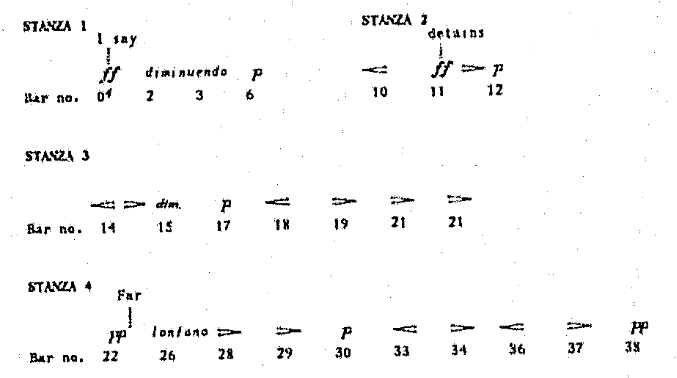 (Van der Watt, 74)
(Van der Watt, 74)
FREQUENCY
"There are 25 indications in the 38 bars which means that on average most of the bars contain an indication. In reality some bars do not contain indications while others contain two or three. There are no separate indications for the voice (other than a single portamento accent on bar 30¹) which implies that the voice should follow the indications given in the piano part."
(Van der Watt, 74)
RANGE
"The lowest level indication, pp, occurs in bar 22 on a single minor triad in the piano part just prior to the start of stanza 4, and in bar 38, the final bar of the song. It is clear that the soft dynamic indications are used in the second half of the song where the emotion of despair has already been established. The highest level indication, ff, on the other hand is exclusively used in the first half of the song (b. 0⁴and 11). The first occurrence helps to establish a feeling of excitement and the second supports the exasperated cry from the beloved: "What indecision detains you, Love, from me?" - the ff on the word "detains"."
(Van der Watt, 74)
VARIETY
"The indications used are:
![]()
(Van der Watt, 74)
DYNAMIC ACCENTS
"Portamento accents have been discussed before. There are stronger accents only in one localized section namely the opening (b. 0⁴- 1⁴) which promoted the sense of anticipation as the lover declares his intention of visiting his beloved."
(Van der Watt, 75)
5. Texture
"The density varies loosely between three and seven parts including both piano and voice. The thickness of the piano part is represented in the following table:"
(Van der Watt, 75)
No. of parts |
No. of bars |
Percentage |
3 parts |
11 |
29 |
4 parts |
21 |
55 |
5 parts |
5 |
13 |
6 parts |
1 |
3 |
"A four- and three-part texture is used in most of the bars (84%). The densest texture is to be found in bars 0⁴- 1⁴, where six-part chords are the most prominent. The thick texture supports the other elements which create an atmosphere of excitement."
(Van der Watt, 75)
"The structure of the song is represented in the following table:"

(Van der Watt, 75)
7. Mood and atmosphere
"The atmosphere of the song declines in stages from elation on the part of the lover to disillusionment on the part of the beloved. These are suggested in the text and are carefully followed in the musical setting:"
Elation and excitement |
Loud dynamics, extreme registers, thick texture, active rhythmic material, minor key |
Uncertainty, sadness |
Diminishing dynamics, descending piano register, thinner texture, rapid modulation |
Hope |
Soft dynamics, high register, thin texture, reasonably active rhythmic material, minor key |
Doubt |
Soft dynamics, middle register, diatonic dissonance, becoming rhythmically inactive |
Disillusionment |
Soft to very soft dynamics, slightly thicker texture, dissonance, rhythmically inactive, metric change |
"A most 'pathetic' little piano motif occurs in bars 19 - 20 on the word "spoiled." It sounds against a sustained i⁶₄in the bass and descends through more than an octave in the upper part and alternative leaps of a fourth down and a second up in the lower part. The indication, ad lib. is used with it and the uncertain, sighing quality makes the listener realize that this current experience is indeed spoiling the 'thing'."
(Van der Watt, 76)
General comment on style
"The use of vocal intervals shows an extremely sensitive attitude to the voice as an instrument. No interval larger than an ascending sixth is used. Non-harmonic tones are extremely prominent, especially on the beat and these result in mild dissonance which enhances the expression of emotion. The harmonic language is fairly conservative and dissonance is often the result of incidental voice-movement, rather than designed harmonic progression. The development of atmosphere is the most prominent feature that creates coherence in a through-composed."
(Van der Watt, 76)


